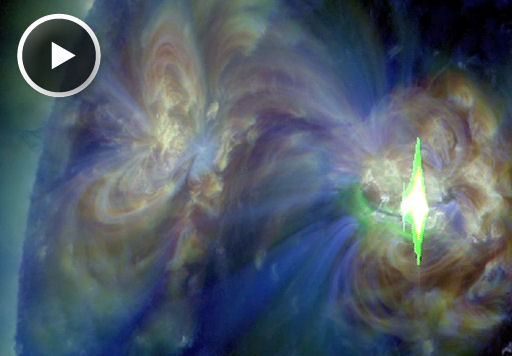Turn your cell phone into a field-tested satellite tracker. Works for Android and iPhone. | | |
GEOMAGNETIC STORM: High-latitude sky watchers should be alert for auroras. A polar geomagnetic storm (magnitude Kp=5) is underway in response to solar wind buffeting Earth's magnetic field.
WHAT LIES INSIDE JUPITER?The clouds of Jupiter hide many mysteries--from the roots of monster storms to possible stores of exotic matter. NASA's Juno spacecraft, scheduled to launch on August 5th, is going to find out what lies inside the giant planet. [full story] [video]
STRONG FLARE: Sunspot AR1261 unleashed a brief but strong M9-class solar flare on July 30th at 0209 UT. NASA's Solar Dynamics Observatory recorded the flare's extreme ultraviolet flash:

Because of its brevity, the eruption did not hurl a substantial cloud of material toward Earth. No CME is visible in SOHO coronagraphs. The eruption was not geoeffective, although future eruptions could be as the active region continues to turn toward Earth. Solar flare alerts: text, voice.
SHAPE-SHIFTING SUNSPOT: Three big sunspot groups are rotating across the Earth-facing side of the sun. One of them, AR1261, is morphing into a circular ring. Click on the image to view a 24-hour movie:

The magnetic field of this shape-shifting sunspot is crackling with C- and M-class solar flares, including a powerful M9-blast to begin the day on July 30th. NOAA forecasters estimate a 40% chance of more such flares during the next 24 hours. Readers with solar telescopes are encouraged to monitor developments.
more images: from Efrain Morales Rivera of Aguadilla, Puerto Rico; from Rogerio Marcon of Campinas SP Brasil; from John Stetson of Falmouth, Maine; from John Minnerath of Crowheart, Wyoming; from Pepe Manteca of Begues, Barcelona, Spain; from Michael Boschat of Halifax, Nova Scotia, Canada; from Monty Leventhal OAM of Sydney. Australia
2011 Noctilucent Cloud Gallery
[previous years: 2003, 2004, 2005, 2006, 2007, 2008, 2009]
June 2011 Aurora Gallery
[Aurora alerts: text, voice] [previous Junes: 2010, 2008, 2001]
Potentially Hazardous Asteroids (
PHAs) are space rocks larger than approximately 100m that can come closer to Earth than 0.05 AU. None of the known PHAs is on a collision course with our planet, although astronomers are finding
new ones all the time.
On July 30, 2011 there were 1237 potentially hazardous asteroids.
Notes: LD means "Lunar Distance." 1 LD = 384,401 km, the distance between Earth and the Moon. 1 LD also equals 0.00256 AU. MAG is the visual magnitude of the asteroid on the date of closest approach. | | The official U.S. government space weather bureau |
| | The first place to look for information about sundogs, pillars, rainbows and related phenomena. |
| | Researchers call it a "Hubble for the sun." SDO is the most advanced solar observatory ever. |
| | 3D views of the sun from NASA's Solar and Terrestrial Relations Observatory |
| | Realtime and archival images of the Sun from SOHO. |
| | from the NOAA Space Environment Center |
| | the underlying science of space weather |
| | for out-of-this-world printing and graphics |

